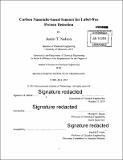| dc.contributor.advisor | Michael S. Strano. | en_US |
| dc.contributor.author | Nelson, Justin T. (Justin Ttheodore) | en_US |
| dc.contributor.other | Massachusetts Institute of Technology. Department of Chemical Engineering. | en_US |
| dc.date.accessioned | 2015-08-20T18:47:47Z | |
| dc.date.available | 2015-08-20T18:47:47Z | |
| dc.date.copyright | 2015 | en_US |
| dc.date.issued | 2015 | en_US |
| dc.identifier.uri | http://hdl.handle.net/1721.1/98162 | |
| dc.description | Thesis: S.M., Massachusetts Institute of Technology, Department of Chemical Engineering, 2015. | en_US |
| dc.description | Cataloged from PDF version of thesis. | en_US |
| dc.description | Includes bibliographical references (pages 31-40). | en_US |
| dc.description.abstract | Optical biosensors based on fluorescent single-walled carbon nanotubes (SWNT) are a promising alternative to conventional biosensors due to the exceptional photophysical properties of SWNT. Such sensors can enable highly-sensitive, selective, and real-time detection of biological analytes. However, important questions regarding sensor fabrication and reproducibility must be addressed for these sensors to be of practical value. Herein we describe the use of highly-purified, single-chirality SWNT which are functionalized for antibody detection, and demonstrate that reproducibility is drastically improved with these SWNT. Further, we observe a concentration dependence of the effective equilibrium dissociation constant, KD,eff, which is in good agreement with previous reports, yet has eluded mechanistic description due to complexities associated with multivalent interactions. We show that a bivalent binding mechanism is able to describe this concentration dependence of KD,eff which varies from 100 pM to 1 uM for IgG concentrations from 1 ng/ml to 100 ug/ml, respectively. The mechanism is shown to describe the unusual concentration-dependent scaling demonstrated by other sensor platforms in the literature, and a comparison is made between resulting parameters. The platform is then extended to the detection of human growth hormone (hGH) using SWNT functionalized with a native hGH receptor (hGH-R), with potential use as a real-time and label-free measurement of protein activity. Native hGH is detected in the micromolar range, and an invariant equilibrium dissociation constant of 9 uM is revealed upon fitting the calibration curve to a single-site adsorption model. Selective detection of native hGH over thermally denatured hGH is shown at a concentration which is 1% of a clinical dose. Lastly, a multichannel detector was built to demonstrate real-time characterization of multiple protein properties. This work could find broad impact in biomanufacturing as real-time analysis of complex biologics is a long-standing goal in this field. | en_US |
| dc.description.statementofresponsibility | by Justin T. Nelson. | en_US |
| dc.format.extent | 40 pages | en_US |
| dc.language.iso | eng | en_US |
| dc.publisher | Massachusetts Institute of Technology | en_US |
| dc.rights | M.I.T. theses are protected by copyright. They may be viewed from this source for any purpose, but reproduction or distribution in any format is prohibited without written permission. See provided URL for inquiries about permission. | en_US |
| dc.rights.uri | http://dspace.mit.edu/handle/1721.1/7582 | en_US |
| dc.subject | Chemical Engineering. | en_US |
| dc.title | Carbon nanotube-based sensors for label-free protein detection | en_US |
| dc.type | Thesis | en_US |
| dc.description.degree | S.M. | en_US |
| dc.contributor.department | Massachusetts Institute of Technology. Department of Chemical Engineering | |
| dc.identifier.oclc | 915368432 | en_US |
